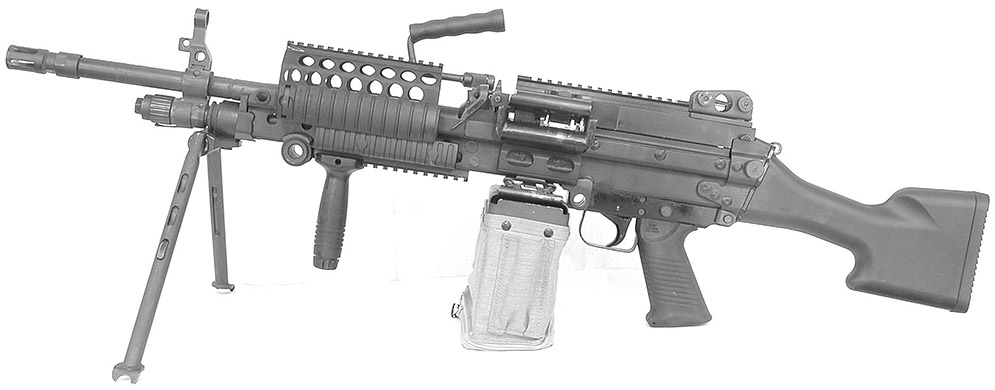
By Dan Shea
As mentioned previously in SAR, there has been a call for a return to 7.62x51mm NATO caliber weapons for certain operations. This request has originated from various Special Operations Groups in the assorted services. FNMI recently very successfully fielded the MK46 machine gun, a lightened, improved version of the famous FN M249 already in US service. SOCOM and various special service groups have adopted this lightened version, a 5.56x45mm weapon. This writer has been involved in numerous tests, trials, and procurements on the MK46, and has seen many satisfied customers.
That being said, the question has been that request from the front lines of special operations, filtered through people in the chain of command, who have a good understanding of the needs of the end users, for a new 7.62x51mm weapon. The aging M60 GPMG, in its current lightweight MK43 designation, is not accomplishing the new mission requirements.
Thus the US Navy through its SOCOM group issued a solicitation for a lightweight 7.62x51mm machine gun. FNMI’s answer was to go to the roots of the Minimi program (subsequently the US M249), covered in one of SAR’s main articles this month. The same individuals who designed the original Minimi in 5.56x45mm had originally done the work in 7.62x51mm. (SAR wanted to credit those designers by name, but FN Herstal desired to simply credit the work to the team as a whole).
The obvious advantages of the M249’s smaller size and lighter weight than the M240 series, make it an excellent candidate for caliber conversion. The major advantage that FNMI had in the design process was, of course, that little known secret – the gun had been in the 7.62x51mm caliber to start. This means that the receiver had the necessary length built into it already for the longer 7.62x51mm cartridge. With the MK46 design, much of the work to design the M249 into a lightweight gun had already been thought through by FNMI’s engineers.
In order to attain reliable feeding under all conditions, there has to be an anti-runaway feature built in. FNMI solved the problem by moving the trigger group back 15mm to allow for that anti-runaway feature and to ensure clearance of the ejecting brass cases with the gunner’s fingers.
At this point in the discussion, SAR would like to point out that the MK48 development was a collaboration between the engineering group at FNMI in Columbia, South Carolina, and the FN Herstal group in Belgium. While based on the original Minimi design, the MK48 is very different from that weapon. The operating group, receiver, top cover, feed tray and bipod have all been significantly changed. In our interviews with the FNMI engineers, they emphasized that the dynamics of the operating group and gas system were developed from stage one. The FNMI engineering staff considers this program to represent a successful integration of talent and knowledge from both sides of the Atlantic.
Specifications supplied to us by James Brunette from the FNMI Engineering Division are as follows:
The MK48 weighs 18 pounds with all accessory rails, bipod, carry handle and fixed stock. The overall length is just less than 40 inches with a fixed stock. The barrel is 421.5mm (just over 16.5 inches) long including chamber length.
The US Navy/SOCOM requirements are based on years of hard experience, and many incidences of weapon system failures in difficult environments. Combat in general is tough on weapons, but the Special Operations groups not only train hard and fight hard, they do so in an incredible variety of environments that corrode or quickly wear out weapons and strategic parts. In answer to this, the finish on the receiver is a combination of hard chrome (on guides), phosphate (on key surfaces with tight tolerances) and Teflon coating. The exterior is Teflon for corrosion resistance. The MK48 had to pass 96 hours in a salt-spray test tank. The barrel bore is hard chromed.
The MK48 is compatible with all US issue 7.62x51mm ammunition, as well as all NATO spec ammo. It utilizes the standard metallic disintegrating links used by the M60 and M240 systems. During testing, M80 / M62 4&1 ammo and blanks were used.
Current orders placed by SOCOM are for 500 to 2,500 guns. The first order is for 513, which seems an odd number, but is typical of procurements. There will be 500 for issue, and a smaller number for assorted testing and other internal system requirements. As the order progresses, the manufacturer and end users will work through to fill the balance of the order. The US Army Rangers have also requested the MK48 for evaluation.
All in all, a very interesting answer to the questions coming from the front lines around the world. Once the initial production run has been finished, SAR has been invited back to FNMI to do a full tilt boogie test run on the MK48 system, and we look forward to bringing you the full specifications and our reaction at that time.
| This article first appeared in Small Arms Review V6N10 (July 2003) |










